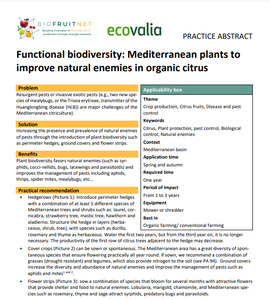{Tool} Functional biodiversity: Mediterranean plants to improve natural enemies in organic citrus (BIOFRUITNET Practice Abstract). Creator(s): Vercher Aznar, Rosa. Issuing Organisation(s): Ecovalia - Asociación Valor Ecológico. Biofruitnet Practice Abstract, no. 083. (2022)
|
PDF
- Published Version
- English
(Functional biodiversity: Mediterranean plants to improve natural enemies in organic citrus)
399kB | |
|
PDF
- Published Version
- Spanish/Español
(Biodiversidad funcional: Plantas mediterráneas para potenciar a los enemigos naturales en cítricos ecológicos)
422kB | |
![[thumbnail of 2023-04-21 15_43_02-Functional biodiversity_ Mediterranean plants to improve natural enemies in orga.png]](/44809/5.hassmallThumbnailVersion/2023-04-21%2015_43_02-Functional%20biodiversity_%20Mediterranean%20plants%20to%20improve%20natural%20enemies%20in%20orga.png)  Preview |
Image (PNG)
- Cover Image
- English
89kB |
Document available online at: https://orgprints.org/44809
Summary in the original language of the document
Plant biodiversity favors natural enemies (such as syrphids, cocci-nellids, bugs, lacewings and parasitoids) and improves the management of pests including aphids, thrips, spider mites, mealybugs, etc...
Practical recommendation
• Hedgerows (Picture 1): Introduce perimeter hedges with a combination of at least 5 different species of Mediterranean trees and shrubs such as: laurel, cornicabra, strawberry tree, mastic tree, hawthorn and aladierno. Structure the hedge in layers (herbaceous, shrub, tree), with species such as durillo, rosemary and thyme as herbaceous. Water the first two years, but from the third year on, it is no longer necessary. The productivity of the first row of citrus trees adjacent to the hedge may decrease.
• Cover crops (Picture 2) can be sown or spontaneous. The Mediterranean area has a great diversity of spontaneous species that ensure flowering practically all year round. If sown, we recommend a combina-tion of grasses (drought resistant) and legumes, which also provide nitrogen to the soil (see PA 94). Ground covers increase the diversity and abundance of natural enemies and improve the management of pests such as aphids and mites.
• Flower strips (Picture 3): sow a combination of species that bloom for several months with attractive flow-ers that provide shelter and food to natural enemies. Lobularia, marigold, chamomile, and Mediterranean species such as rosemary, thyme and sage attract syrphids, predatory bugs and parasitoids.
| EPrint Type: | Practice tool |
|---|---|
| What problem does the tool address?: | Resurgent pests or invasive exotic pests (e.g., two new species of mealybugs, or the Trioza erytreae, transmitter of the Huanglongbing disease (HLB)) are major challenges of the Mediterranean citriculture). |
| What solution does the tool offer?: | Increasing the presence and prevalence of natural enemies of pests through the introduction of plant biodiversity such as perimeter hedges, ground covers and flower strips. |
| Country: | Spain |
| Type of Practice Tool: | Practice abstracts |
| Keywords: | Citrus, Plant protection, pest control, Biological control, Natural enemies |
| Agrovoc keywords: | Language Value URI English Citrus http://aims.fao.org/aos/agrovoc/c_1637 English plant protection http://aims.fao.org/aos/agrovoc/c_5978 English pest control http://aims.fao.org/aos/agrovoc/c_5726 English biological control http://aims.fao.org/aos/agrovoc/c_918 English natural enemies http://aims.fao.org/aos/agrovoc/c_5085 |
| Subjects: | Environmental aspects > Biodiversity and ecosystem services Crop husbandry > Production systems > Fruit and berries |
| Research affiliation: | European Union > Horizon 2020 > Biofruitnet Spain > Other organizations Spain European Union > Organic Farm Knowledge |
| Horizon Europe or H2020 Grant Agreement Number: | 862850 |
| Related Links: | https://organic-farmknowledge.org/tool/44809, https://organic-farmknowledge.org/tool/44866, https://biofruitnet.eu |
| Project ID: | ofk |
| Deposited By: | Basler, Andreas |
| ID Code: | 44809 |
| Deposited On: | 10 Dec 2022 17:26 |
| Last Modified: | 02 May 2024 10:32 |
| Document Language: | English, Spanish/Español |
| Status: | Published |
Repository Staff Only: item control page

 Download Statistics
Download Statistics Download Statistics
Download Statistics
